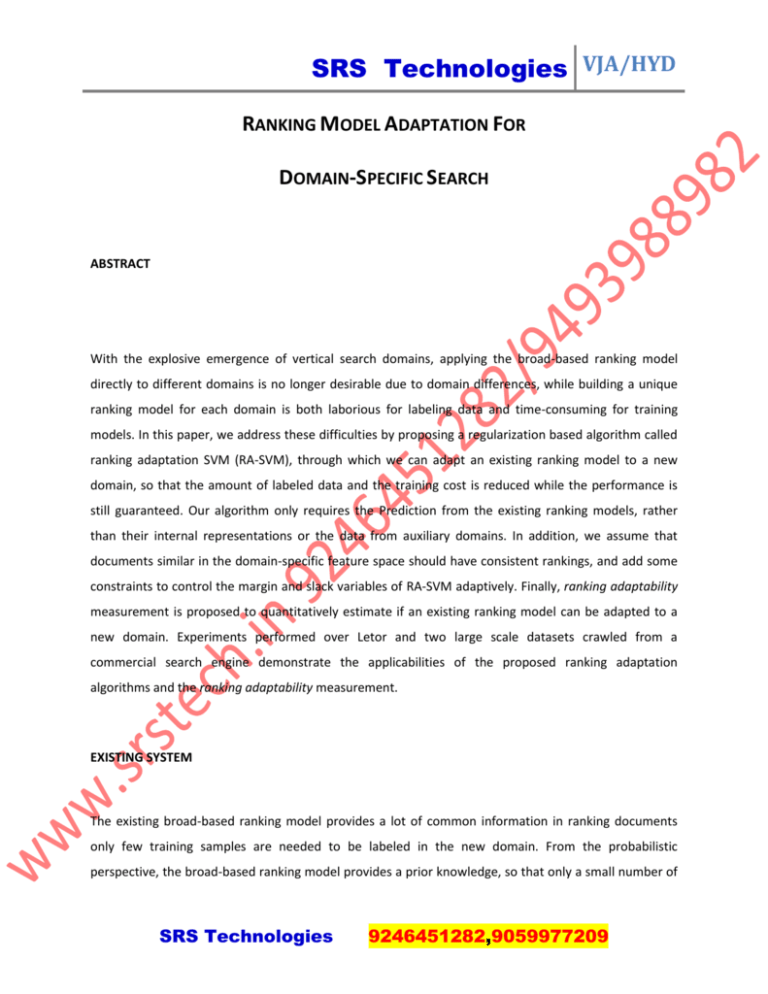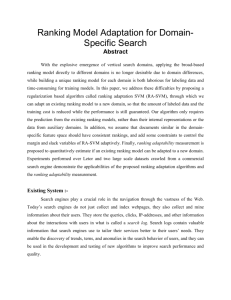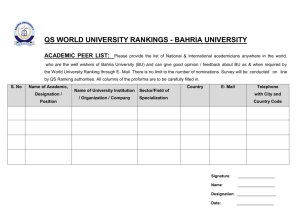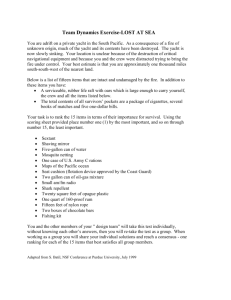svm finally
advertisement

SRS Technologies VJA/HYD RANKING MODEL ADAPTATION FOR DOMAIN-SPECIFIC SEARCH ABSTRACT With the explosive emergence of vertical search domains, applying the broad-based ranking model directly to different domains is no longer desirable due to domain differences, while building a unique ranking model for each domain is both laborious for labeling data and time-consuming for training models. In this paper, we address these difficulties by proposing a regularization based algorithm called ranking adaptation SVM (RA-SVM), through which we can adapt an existing ranking model to a new domain, so that the amount of labeled data and the training cost is reduced while the performance is still guaranteed. Our algorithm only requires the Prediction from the existing ranking models, rather than their internal representations or the data from auxiliary domains. In addition, we assume that documents similar in the domain-specific feature space should have consistent rankings, and add some constraints to control the margin and slack variables of RA-SVM adaptively. Finally, ranking adaptability measurement is proposed to quantitatively estimate if an existing ranking model can be adapted to a new domain. Experiments performed over Letor and two large scale datasets crawled from a commercial search engine demonstrate the applicabilities of the proposed ranking adaptation algorithms and the ranking adaptability measurement. EXISTING SYSTEM The existing broad-based ranking model provides a lot of common information in ranking documents only few training samples are needed to be labeled in the new domain. From the probabilistic perspective, the broad-based ranking model provides a prior knowledge, so that only a small number of SRS Technologies 9246451282,9059977209 SRS Technologies VJA/HYD labeled samples are sufficient for the target domain ranking model to achieve the same confidence. Hence, to reduce the cost for new verticals, how to adapt the auxiliary ranking models to the new target domain and make full use of their domain-specific features, turns into a pivotal problem for building effective domain-specific ranking models. PROPOSED SYSTEM Proposed System focus whether we can adapt ranking models learned for the existing broad-based search or some verticals, to a new domain, so that the amount of labeled data in the target domain is reduced while the performance requirement is still guaranteed, how to adapt the ranking model effectively and efficiently and how to utilize domain-specific features to further boost the model adaptation. The first problem is solved by the proposed rank-ing adaptability measure, which quantitatively estimates whether an existing ranking model can be adapted to the new domain, and predicts the potential performance for the adaptation. We address the second problem from the regularization framework and a ranking adaptation SVM algorithm is proposed. Our algorithm is a blackbox ranking model adaptation, which needs only the predictions from the existing ranking model, rather than the internal representation of the model itself or the data from the auxiliary domains. With the black-box adaptation property, we achieved not only the flexibility but also the efficiency. To resolve the third problem, we assume that documents similar in their domain specific feature space should have consistent rankings. Advantage: 1. Model adaptation. 2. Reducing the labeling cost. 3. Reducing the computational cost. MODULE DESCRIPTION: SRS Technologies 9246451282,9059977209 SRS Technologies VJA/HYD Number of Modules After careful analysis the system has been identified to have the following modules: 1. Ranking Adaptation Module. 2. Explore Ranking adaptability Module. 3. Ranking adaptation with domain specific search Module. 4. Ranking Support Vector Machine Module. 1.Ranking adaptation Module: Ranking adaptation is closely related to classifier adaptation, which has shown its effectiveness for many learning problems. Ranking adaptation is comparatively more challenging. Unlike classifier adaptation, which mainly deals with binary targets, ranking adaptation desires to adapt the model which is used to predict the rankings for a collection of domains. In ranking the relevance levels between different domains are sometimes different and need to be aligned. we can adapt ranking models learned for the existing broad-based search or some verticals, to a new domain, so that the amount of labeled data in the target domain is reduced while the performance requirement is still guaranteed and how to adapt the ranking model effectively and efficiently .Then how to utilize domain-specific features to further boost the model adaptation. 2.Explore Ranking adaptability Module: Ranking adaptability measurement by investigating the correlation between two ranking lists of a labeled query in the target domain, i.e., the one predicted by fa and the ground-truth one labeled by human judges. Intuitively, if the two ranking lists have high positive correlation, the auxiliary ranking model fa is coincided with the distribution of the corresponding labeled data, therefore we can believe that it possesses high ranking adaptability towards the target domain, and vice versa. This is because the labeled queries are actually randomly sampled from the target domain for the model adaptation, and can reflect the distribution of the data in the target domain. SRS Technologies 9246451282,9059977209 SRS Technologies VJA/HYD 3.Ranking adaptation with domain specific search Module: Data from different domains are also characterized by some domain-specific features, e.g., when we adopt the ranking model learned from the Web page search domain to the image search domain, the image content can provide additional information to facilitate the text based ranking model adaptation. In this section, we discuss how to utilize these domain-specific features, which are usually difficult to translate to textual representations directly, to further boost the performance of the proposed RA-SVM. The basic idea of our method is to assume that documents with similar domain-specific features should be assigned with similar ranking predictions. We name the above assumption as the consistency assumption, which implies that a robust textual ranking function should perform relevance prediction that is consistent to the domain-specific features. 4.Ranking Support Vector Machines Module: Ranking Support Vector Machines (Ranking SVM), which is one of the most effective learning to rank algorithms, and is here employed as the basis of our proposed algorithm. the proposed RA-SVM does not need the labeled training samples from the auxiliary domain, but only its ranking model fa. Such a method is more advantageous than data based adaptation, because the training data from auxiliary domain may be missing or unavailable, for the copyright protection or privacy issue, but the ranking model is comparatively easier to obtain and access. SOFTWARE REQUIREMENTS: Operating System : Windows SRS Technologies 9246451282,9059977209 SRS Technologies VJA/HYD Technology : Java and J2EE Web Technologies : Html, JavaScript, CSS IDE : My Eclipse Web Server : Tomcat Tool kit : Android Phone Database : My SQL Java Version : J2SDK1.5 HARDWARE REQUIREMENTS: Hardware : Pentium Speed : 1.1 GHz RAM : 1GB Hard Disk : 20 GB Floppy Drive : 1.44 MB Key Board : Standard Windows Keyboard Mouse : Two or Three Button Mouse Monitor : SVGA SRS Technologies 9246451282,9059977209 SRS Technologies VJA/HYD SRS Technologies 9246451282,9059977209






